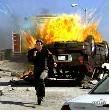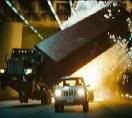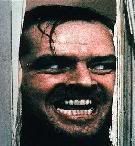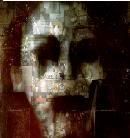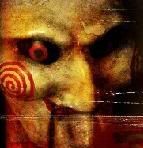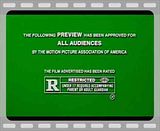
Saturday, 2 May 2009
Farewell

Friday, 1 May 2009
Evaluation
On the one hand, our production is a thriller, as it follows many of the conventions of a real thriller, such as the crime involved with the narrative. Moreover, we have protagonists and an antagonist, where there is a relationship between them, and are trapped in a web of intrigue which is directed by the antagonist. Furthermore, thrillers also show extraordinary events happening in ordinary situations, which apply to our product as, which is the whole aspect of the thriller. This shows that we understand the genre, and have applied it to our product. On the other hand, our product challenges some of the conventions of media products. Often thrillers set in dark places; however, we have filmed in bright light conditions. The protagonists don’t have a flaw which can’t be exploited, as they are all confident and well formed teenagers, with typical teenage issues.
2. How does your media product represent particular social groups?
Our media product represents one particular social group; teenagers. We follow the social and emotion aguish of many young people going through their teenager years, which could lead to distress and result in deadly actions.
Other social groups were not represented in our product, due to the results of our target audience which was; “a mixture between Crime, Horror, Psychological and Action. They are more interested in spotting clues to attempt to work out the plot of the story. However, shockers are appreciated and as are the suspense of the film.” Furthermore, due to the fact it was a project created by teenagers we were limited.
3. What kind of media institution might distribute your media product and why?
Due to recent research into film distributors in media studies, Film4 may distribute our product, because Film4 seeks to broadcast a variety of films which are independent, old, new, art house, British films as well a foreign language ones. Our product is made by independent amateurs, media students, and is an amateur film, which is creatively done. Moreover, it could be used for media classes, who could use it as an example for students doing media, in which they could evaluate for coursework or project purposes. Also, institution such as local community may as well to showcase local talent, in which they could also distribute to schools or events. Moreover, film festivals may also as well, as they show a variety of films/talents/entertainment, which celebrate the success of film media.
4. Who would be the audience for your media product?
From research and personal experiences, our media product would be rated for a certificate 15, and therefore our audience would be anyone over the age of 15, due to the material involved. Furthermore, I also think if we’re going to name a specific target, then teenagers and young adults, because it was set in a school, as well as it featuring teenagers who are representing them and they can relate to them. Moreover, I also think that our thriller would be attracted to the niche market, as it is more of an art house film, in which it is an independent film which expresses serious matters, and was produced by amateurs’ teenage film makers. Moreover, because it features teenagers, this is another factor that would attract an audience, as it’s a representation of them, and they can relate to the characters as well.
5. How did you attract/address your audience?
We addressed our audience by producing a questionnaire. We ask them many questions, including their age and well as gender. Furthermore we asked what types and kind of thriller they like, and what they look for in a thriller. Our results came back informing us that there were teenagers between that age of 15 to 25, who enjoyed “a mixture between Crime, Horror, Psychological and Action. They are more interested in spotting clues to attempt to work out the plot of the story. However, shockers are appreciated and as are the suspense of the film”. Moreover, half were male and half were female, which was useful as we therefore knew that we could product a good thriller which would appeal to both.
We have applied this to our storyboard, which includes crime and the psychological aspect. Moreover, there is suspense and a gripping narrative, which allows our audience to work out the plot. Despite the storyboard having a change of plans, it still follows the results of our survey.
Our product also uses visual effects and creativity, which will attract our audience, as we show why our antagonist is psychologically distressed. Our audience will realise that the actions taken will not be the answer of resolving the situation between friends, and therefore this type of film may be useful to young teenagers who result to crime when in trouble.
6. What have you learnt about technologies from the process of constructing this product?
In the process of constructing our product we learn how to use the camera, iMac and the iMovie software. When doing Preliminary Exercise we used the camera, in which it was the first time in using it. By doing this we learnt how to do different camera angles and movements; it was quite like a training programme. We also learn about continuity, the 180 degree rule and match one action. When it came to editing we only knew how to do straight cuts. However, later when working with iMovie, I learnt how to use different transitions such as dissolve cross and overlap, along with effects to use. The technology actually amazed me, and I was excited at the amount of effects I could use for the thriller. The iMac is more effect and efficient and contains many software that enabled us to Bluetooth pictures for our blog as well as being used for storyboards. However, at the beginning using the Mac was extremely difficult, because I had never used it before and often got frustrated at the beginning. However, after getting use to it, it became easy. Moreover, when we was editing, that was quite difficult to understand, and it required patients and a good eye to edit in the right place. Working with iMovie can often cause problems, if there is too much going on, and we had to remember to save our work every time, otherwise we would have had to start again. I learnt that after we lost all the work we done on your preliminary.
7. Looking back at your preliminary task, what do you feel you have learnt in the progression from it to the product?
I’ve felt that I have learnt an extreme about of media; teamwork, editing, filming, production, the skill of problem solving and much more. When we first started, with the preliminary, it was a great opportunity to understand the works of the camera and editing. However, we only got the basics of filming and editing, which would later provide and useful understanding later in the process of our thriller. In the preliminary, we only had done a few camera angles, positioning and movement. In the progression to our product, we have learnt so much more. We experimented with a lot of different camera movements, although not everything ended up in the product, however we did shot the same thing in different angles as well. When editing our preliminary they were only straight cuts and nothing else. However, compared to our product, there is a variety of different editing such as dissolve, and overlap as well as effects such as a wash out and fade to black and the use of colour. Also, I’ve learnt that organisation and planning is the key in finishing the end product, as well meeting/discussions as it allows us to use our time wisely. However I believe that planning, when it came actually doing the filming, could have been better. Moreover, I have also learnt that teamwork and cooperation within the team is essential. We did work together really well and combine our talents to create a good product.
Within myself, I have learnt that I am no actress, and will forever stick to filming, editing and direction when doing such projects. Also, I work well under pressure and now understand that the work involved in creating such films and media products must be very stressful.
Im so Proud of it I put my Name on it!
The topping of our media project, so prepare the popcorn, and enjoy the movie!
Decided Title
Our Last Filming; Goodbye My Friend
Techniques
Framing a Shot: Furthermore, the positioning of the antagonists in the flashback shows how gradually he is being outcast by the group of friend. In one shot he is in the center of two friends which show he will come between them. Also, the position the camera in the center so that at one point the that actors walk past each other, we could see the reaction of both. We also centered the camera, so that match-on-action could be seen, as so that we could see both character. Also, an over the shoulder shot was use, in which it was positioned so we could see what was processing when the antagonists arranged the photo and when he was holding us the photo, so we could show who he was killing next.
Using a variety of shot distances: we used different shots, which each show information of the actions, and can also show emotion. We used long shots, to give a wide view of what was happening in the shot. Mid shot, which was used to show interaction. Close Up were also use to show emotion of the characters as well as Extreme Close Up which really can show the emotion the actors are portraying.
Shooting appropriate material: the material shot was relevant to thriller, following the genre of thriller. We didn't films such things like hopping birds or a whole romance scene, as it is not appropriate, as they are suitable for a romantic genre. We filmed what was relevant to what we wanted to produce, in the genre; thriller.
Editing: in the editing process we used a variety of shots including dissolve, overlap, wash out and fade to black. Moreover, we used effects such as a flash and the use of colour; red, filled the whole shot of the antagonist's close up to show his angry and that he is dangerous. The editing was slow in some part to build suspense, and at the beginning to establish the protagonists and antagonists.
Mise-en-Scene: our antagonists was dressed in black, to show he was our dark and dangerous character. our protagonists is also in dark clothing, however, it is more uniform based as she is in a school environment. The lockers and corridor establish that we are in a school or college environment. The characters were also in the shot, so we could show what was happening. In one shot we place a table with photos, in which the antagonists made a college. This showed that he was looking back, deciding who to kill next.
Using sound: No diegetic sound was not often used, otherwise this would have ruined the effect and could ruin the project, the only diegetic sound used was the sound of the tearing and the falling arm, which was use for effect. On a whole, we used non-diegetic sound, which was the track. The music was suspenseful and quite dramatic which worked well with the series of shots.
Thursday, 30 April 2009
One more thing
freeplaymusic.com
Editing...again
Wednesday, 29 April 2009
Editing (more information)
Tuesday, 28 April 2009
Filming 2
Monday, 27 April 2009
Editing
Saturday, 25 April 2009
Production
Friday, 24 April 2009
Filming
Thursday, 23 April 2009
New Storyboard
Wednesday, 22 April 2009
A Change of Plans
Actors
Antagonists: Joesph Uhama
Protagonist: Gemma Castle
Next Victims in Photo: Hannah Poole & Shaunica Lynch
Monday, 20 April 2009
Finally
Wednesday, 15 April 2009
Updates
Sunday, 12 April 2009
Im Worried
Thursday, 9 April 2009
Im Back
Killer: Joesph
Victim 1: Gemma Castle
Victim 2: Katie Anderson
Victim 3: Shaunica Lynch
This will hopefully be sorted in the next coming days and then we can begin filming.
Thursday, 2 April 2009
03 April - 08 April

Wednesday, 1 April 2009
Friday, 27 March 2009
Results

8 out of 12 of the people we surveyed preferred to “Think and try and work out the plot” rather than to “Sit and enjoy the film” which received 4 out of the 12 people. This tells us that our thriller needs to have a strong plot which allows the audience to think so that they can be involved, and so that it keeps the interested.

Horror and Crime both received the highest votes which was 6 each. Action and Psychological also received the same votes which was 4 each. However, Sci-Fi and Spy are shown as not being the sub-genre they enjoy in our young audience.
In conclusion our audience are citizens who enjoy a mixture between Crime, Horror, Psychological and Action. They are more interested in spotting clues to attempt to work out the plot of the story. However, shockers are appreciated and as are the suspense of the film.
Wednesday, 25 March 2009
Target Audience
 1.Gender?
1.Gender?2. Age?
3. What sort of thrillers do you enjoy?
Crime. Physiological. Action. Horror. Sci-Fi. Spy
4. What appeals most to you in a thriller?
The Story. The Cast. The Director. Music/Soundtrack. Others
5. What do you concentrate more on in a thriller?
The Protagonists. The Antagonists. Spotting Anomalies. Settings.
6. Do you prefer:
To think and try and work out the plot OR Sit and enjoy the film?
7. You like what in a thriller?
Suspense. Humour. Blood & Gore. Cliff Hangers. Shockers
These were the questions asked in our questionnaire, designed and composed by me, Carla. The results will appear next week, to confirm what our target audience is.
The Storyboard: "Virus"
Sunday, 22 March 2009
MobyGratis
Wednesday, 18 March 2009
Storyboard: Complete
Friday, 13 March 2009
Storyboard - In production
Wednesday, 11 March 2009
The Preliminary Exercise - Completed
This is our Preliminary Exercise. We understand that there is one continutiy problem, and we hope by telling you this, that it shows you that we understand. I shan't tell you what it is, i shall let you try and find it. But this exercise was to show us how to edit and to understand the problems that may occur. As we have done a mistake, we now understand how important it is, and will take note of this.
Saturday, 7 March 2009
Death Note - I love It
 Recently this film was broadcasts on FilmFour, and myself and my friend commit ourselves to watch a film on this channel on Saturdays. The film DEATH NOTE, which we had heard from another friend that we had to see it. (And once i did see it i had like the biggest discussion with this friend, who said he preferred the amine to the movie, however i preferred the movie, and then started to watch the amine which i did however like: BUT THE FILM IS BETTER!). Anyway, i am absolutely in love with this film, and have actually brought it now, some I'm happy! So, Dear Mr Examiner, i recommend you watch this film, if you haven't already. Its in Japaneses, but their are subtitles, but this way you can understand it better.
Recently this film was broadcasts on FilmFour, and myself and my friend commit ourselves to watch a film on this channel on Saturdays. The film DEATH NOTE, which we had heard from another friend that we had to see it. (And once i did see it i had like the biggest discussion with this friend, who said he preferred the amine to the movie, however i preferred the movie, and then started to watch the amine which i did however like: BUT THE FILM IS BETTER!). Anyway, i am absolutely in love with this film, and have actually brought it now, some I'm happy! So, Dear Mr Examiner, i recommend you watch this film, if you haven't already. Its in Japaneses, but their are subtitles, but this way you can understand it better. This is the Movie Trialier for Death Note.
Friday, 6 March 2009
Planning
We have also came up with a name for our thriller:
Wednesday, 4 March 2009
Preliminary Exercise - Shock 2
So Hannah needed to go, so i said i will stay all lunch and after that until it was finished. I had some trouble with the camera because the audio was scattering. So i had to change the camera, and then it wouldnt let me edit. So i had to import many times so i could cut it. But, finally, it worked and its all sorted.
Now we can work towards our Thriller Trailer!
Monday, 2 March 2009
Update on Preliminary Exercise - A Shock Experience
When it came to editing Shanuica took control as she knew what she was doing. Myself and Hannah added comments and established were it needed to be cut and helped. However, me and Hannah had went to get something from the other room, i looked through the door when we was returning and by Shanuica's dramatic movements and shocked face expression, something had gone horrible wrong. She had accidentally lost all the work she had done, when she watched it on full screen, and accidentally clicked exit, shutting the project done.
After some fussing about, Shanuica was determined to do it again in 30minutes, and she was DETERMINED! and she done it in 15. And it was really good. We just have to touch up on it and it should be posted sometime next week.
Wednesday, 25 February 2009
Expanding Ideas
Media Planning – name n/a ?
Storyline: Teenagers receive an email, which contains a nursery rhyme which is missing the last two rhymes. Once spoken, the antagonist kills them.
The Email
The nursery rhyme: Orange and Lemons
Oranges and lemons", say the bells of St. Clement's
"You owe me five farthings", say the bells of St. Martin's
"When will you pay me?" say the bells of Old Bailey
"When I grow rich", say the bells of Shoreditch
"When will that be?" say the bells of Stepney
"I do not know", says the great bell of Bow
Please tell me what the next two lines are?
(Here comes a candle to light you to bed
Here comes a chopper to chop off your head)
If we get like a person, to be the antagonists, they could be like sitting in a chair, with a black cloak, hiding their face and they say each line. However, after each line, we could like fade to black, and then like we have the name of people and stuff. Or, we could do jump cuts to the person sitting in the chair. The last two lines won’t be said by antagonist. And then we go to like a person reading the email, in their bedroom with all the lights off, and they say the last two lines, and then it could like fade to black and we hear screams and stuff. But like when she says “Here comes a candle to light you to bed”, the antagonist could be sitting on the bed and then suddenly we could see the candle behind them. And then we could have a close up of the person dead face. And then we could do the whole thing we said about split shots of others and stuff.
Thursday, 19 February 2009
Preliminary Exercise
This exercise should demonstrate:
Continuity - is consistency of the characteristics of persons, plot, objects, places and events seen by the reader or viewer. Most productions have a script supervisor on hand whose job is to pay attention to and attempt to maintain continuity across the chaotic and typically non-linear production shoot. Errors could include items of clothing change colours, shadows get longer or shorter, items within a scene change place or disappear.
Match on action - It is a cut in film editing from one scene to another, in which the two camera shots' compositional elements match, helping to establish a strong continuity of action.
Shot/reverse shot - film technique wherein one character is shown looking (often off-screen) at another character, and then the other character is shown looking "back" at the first character. Since the characters are shown facing in opposite directions, the viewer assumes that they are looking at each other.
The 180-degree rule - is a basic film editing guideline that states that two characters (or other elements) in the same scene should always have the same left/right relationship to each other. If the camera passes over the imaginary axis connecting the two subjects, it is called crossing the line. The new shot, from the opposite side, is known as a reverse angle. Example: In the example of an action scene, such as a car chase, if a vehicle leaves the right side of the frame in one shot, it should enter from the left side of the frame in the next shot. Leaving from the right and entering from the right will create a similar sense of disorientation as in the dialogue example.
Bibliography
http://en.wikipedia.org/wiki/Match_cut
http://en.wikipedia.org/wiki/Shot_Reverse_Shot
http://en.wikipedia.org/wiki/Continuity_(fiction)
Monday, 16 February 2009
Se7en Opening Titles
This opening titles of Se7en uses this oppuntinity to show the antagoinst state of mind. The music uses high pitched sweaks and the edgy titles never stay still. This shows the antagonist is always thinking of something or that he/she like shaking with ideas and thoughts. The editing is very quick and alot of jump cuts are used to shows how mad the antagonist is. There are shots that overlap shots, to show that the person is very ditrubed and also the actions being showed show this aswell. Moreover, the shots are very fast, and there are lots of flashes to shows how busy and how mad the mind of the antagonist is.
I think this is extremely effect and is a great example of the start of this thriller.
Saturday, 14 February 2009
Rear Window - Hitchcock
As always, Hitchcock tells his story visually, and when we are first shown of our protagonist, we understand that he is extremely hot, by the use of montage. We see a close up of his faces, with beads of sweat falling off his face, and we are then shown the thermometer which shows a very high temperature of over 90°. We are then shown that his leg is in a cast with has written on it “Here lies the broken bones of L. B. Jefferies, therefore we now know the man’s name. He is therefore unable to walk as he is in a wheelchair. We understand that he is a photographer whose, like his broken bones, camera is broken, which implies he may have been involved in an accident, when doing his job, resulting in his broken leg. We also understand that he photographs action in dangerous environment. Moreover, we see magazine, and also understand that he photographs women for a magazine. The use of Point of View shots explains to use that this is what Jefferies does all day as this film mainly uses this effect, which is called voyeurism. Therefore, Jefferies is the voyeur, a person who watches or spies on people who are engaged in something.
Thursday, 12 February 2009
Psycho
 I watched Psycho, which started at 11pm last night, and i was in awe about how amazing the film actually was! I was actually terrified when i finished watching it about 12:50am. It was just outstanding and i really enjoyed it. The suspense of the music by Bernard Hermann really made the movie for me. It was dramatic and suspenseful, and really made the movie. Alfred Hitchcock has really done some amazing work creating Psycho and i now understand why this film is voted one of the BEST Thrillers ever made.
I watched Psycho, which started at 11pm last night, and i was in awe about how amazing the film actually was! I was actually terrified when i finished watching it about 12:50am. It was just outstanding and i really enjoyed it. The suspense of the music by Bernard Hermann really made the movie for me. It was dramatic and suspenseful, and really made the movie. Alfred Hitchcock has really done some amazing work creating Psycho and i now understand why this film is voted one of the BEST Thrillers ever made. Wednesday, 11 February 2009
Hitchcock Day
The Saboteur was on Channel 4 whilst Topaz was on SkyMovies, but i got bored of Topaz and watched Saboteur, which i really like...but i fell asleep like half way through it. Not that is was boring, cause it was really good and i wanted to watch it and i want to know what happens and what Fry is doing. But, i fell asleep.
Tuesday, 10 February 2009
Vertigo - Opening Titles & Sequence
"Hitchcock's film is about obsession, which means that it's about circling back to the same moment, again and again ... And the music is also built around spirals and circles, fulfilment and despair. Herrmann really understood what Hitchcock was going for — he wanted to penetrate to the heart of obsession.” – Martin Scorsese, Sight and Sound, 2004
We see the face of a woman, and as we move to her lips, we hear dramatic music, by Bernard Hermann. Again we move to her eyes and the music becomes strong and powerful, but at each of these moments, the credits of actors come up. The camera then moves to her right eye, and suddenly the whole screen turns red. This is a connotation, and we automatically think of danger, and her eye widens to emphasise this. However, it could also indicate lust; but overall, it gives us an idea of what the film many include.
Then there is the use of graphic match, with the eye and the swirls, with gradually what we follow. The opening credits continue using this effect of swirl patterns, to reflect to the feeling of vertigo, making the audience dizzy (well certain people. Hannah was sitting next to me and she said it made her dizzy, and I heard others as well. It had no affect on me, but after a while, I realised it did). The swirls change colour, supporting the vertigo feel, of faintness and giddiness. This was created by Saul Bass, employing kinetic typography.
The shot of the woman’s face/eye, with the screen totally red, re-appears reinforcing the danger, and lust of this film. It then fades to black and we are then shown the opening sequence.
Vertigo – Open Sequence
The sequence if of a action chase scene as we see the close up shot of a man’s hand, which is followed by his body; we understand later when the police officer and detective John “Scottie” Ferguson, played by James Stewart. The sound of the music is extremely of a fast pace, as well as suspenseful and dramatic. The greatest effect used in the sequence is the use of ‘reverse zoom’. When the detective falls off the roof and hold on to the bar, and looks down, the effect is use to show us his fear of heights: vertigo.
The shots at the beginning are very long, so that we can obtain the information we need to understand what is going on. As well as this, long shot and panning is used, so that again, we obtain enough information and so we can see what is going on. The shots don’t become fast until the detective falls, and the music become of a faster pace. The music become more dramatic when the police man falls trying to save the detective, as we see him plummet to his death. The detective’s expression becomes more fearful, whilst hanging on for dear life, to convey the effects of vertigo.
Shadow of a Doubt (1943)
(Please note that I’ve only analysed the first 7:30 minutes)
"Shadow of a Doubt” starts with a posh ballroom setting with people dancing; the soundtrack (non-digetic sound) is “The Merry Widow”, which later is symbolic to the film. Sound bridge and a dissolve editing are used to give a smooth transfer into an industrial, run down long shot scene. We then see many dissolve editing as we move closer into the industrial scene, and then go closer into a long shot of the poor and messy neighbourhood. We then experience more dissolves as we move closer to the window, this is a familiar editing Alfred Hitchcock does – as seen in “Psycho”. We then see a man lying on a bed, and therefore assume that he is in the room via the window that we were being dissolved closer too.
The way the man is lying on the bed and his surroundings tell us a lot about the character – mise en scene. Firstly, the man appears as if he is dead, with his eyes close, however his hand is moving. He wears black clothing with is extremely well made, and he is smartly dressed, which shows he is powerful and gives him sophistication, as well the cigarette adds to his character. As the camera pans, we see money, showing that he is rich, although, as well as this there is money on the floor which shows that he not bothered about money. Moreover, the lack of facial expression shows he is not bothered, when the maid speaks to him.
The lighting in the room is low key lighting, causing shadows, making him appear dark and mysterious. When the maid puts the blind down and the room becomes darker, the man, Uncle Charlie, comes to life, stating his is like a creature of the night. This is all told by Hitchcock visually, without the use of dialogue telling us his character.
The music becomes suspenseful and gradually builds dramatically as Uncle Charlie smashes his glass on the floor. This shows he is very angry and a violent character. We hear, again, the Merry Widow music, which is foreshadowing, meaning to hint that there is trouble or something bad is going to happen, either now or later in the film. Moreover, Uncle Charlie comes out of the house, and the house number is “13” and very superstitious number for a bad omen.
As the two men follow Uncle Charlie, they move to the sound of music played by a piano to create tension. Further on, the silhouette of Uncle Charlie on the roof gives a powerful image to him and a mysterious feel, as he looks down at the two men who were following him making them appear small and weak.
Mirroring
 “Mirroring is a human behavior characterized by copying someone else while communicating with them. It is often observed in people exhibiting similar postures, gestures, or tone of voice. It may include miming gestures, movements, body language, muscle tensions, expressions, tones, eye movements, breathing, tempo, accent, attitude, choice of words, metaphors, or other features discernible in communication.” - http://en.wikipedia.org/wiki/Mirroring_(psychology)
“Mirroring is a human behavior characterized by copying someone else while communicating with them. It is often observed in people exhibiting similar postures, gestures, or tone of voice. It may include miming gestures, movements, body language, muscle tensions, expressions, tones, eye movements, breathing, tempo, accent, attitude, choice of words, metaphors, or other features discernible in communication.” - http://en.wikipedia.org/wiki/Mirroring_(psychology)In the scene, when we met Charlie, Uncle Charlie’s niece. We see the perfect suburban life and city; Santa Rosa, which is posh, sophisticated, pleasant and a happy, cheerful and joyful people. A contrast to the industrial scene, which is shown in the same way, through dissolve editing. This is, therefore, mirroring. As well, the music is much more pleasant to enhance this visually, the contrast between the two places. The same as when we are dissolved via window into Uncle Charlie room, the same process happens into the girl, Charlie, room. She is positioned exactly like Uncle Charlie was, lying on the bed, however, moving more and alive. This shows they are very much similar but also very different. It is as if Uncle Charlie represents the dark and Charlie represents the light. As well as this, light falls on her face, and the room if much more lighter than that of Uncle Charlie, which enhances the idea.
Alfred Hitchcock
Friday, 30 January 2009
Sub-Genres
Action Thriller: "In which the work often features a race against the clock, contains lots of violence, and an obvious antagonist. These films usually contain large amounts of guns, explosions, and large elaborate set pieces for the action to take place. These films often have elements of mystery films and crime films but these elements take a backseat to action." [Wikipedia]
Horror Thriller: "In which conflict between the main characters are mental, emotional, and physical...What sets the horror thriller apart is the main element of fear throughout the story. The main character(s) is not only up against a superior force, but they are or will soon become the victims themselves and directly feel the fear that comes by attracting the monster's attention. " [Wikipedia]
All quotes come from http://en.wikipedia.org/wiki/Thriller_(genre)
Therefore, there are many thriller that have different elements of other genres in them. This could be applied to our Thriller, which we are in the process of producing, however, we must distinguish it more of a thriller element.
Thriller Conventions
- a crime at the core of the narrative (often murder, but not always)
- a complex narrative structure, with false paths, clues and resolutions
- a narrative pattern of establishing enigmas (problems) which the viewer expects to be resolved
- a protagonist who is systematically, dis-empowered and drawn into a complex web of intrigue by an antagonist.
- Extraordinary events happening in ordinary situation
- Themes of identity
- Themes of mirroring
- Themes of voyeurism
- Protagonist with a "flaw" which is exploited by the antagonist
- Titles often reflect an aspect of the protagonist/antagonist's psychological state
- there is often a scene near the end of the film in which the protagonist is in peril
- Mise-en-Scene which echoes/mirrors the protagonist plight
Protagonist - is the main/central character of a story, the leading actor; it doesn't matter whether they are the hero or the villain.
Antagonist - is the character that is opposed/ a rival against the Protagonist
Thursday, 29 January 2009
A Comparison: Horror vs. Thriller
The Horror: Hostel (2005)
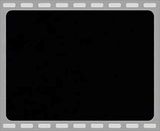
In Hostel, the setting is very dark and gruesome (Film Noir: a black film, which is a key feature in horror films). Moreover, we see rooms, which are clearly used for torturing people, which contain blood and weaponry. The music being played, which is non-diegetic, which is very...it begins slow, however begins to speed up and then become a fast pace, which creates and sense of suspense. The use of diegetic sounds, such as the scream, cries and the slicing of knives, makes the audience consume the fact that it is of a horror nature, making us also feel terrified or even make the audience jump. The use of lethal props, such as drills, knives, clippers and a bloody chair, alerts the audience the dark, deathly, deadly and horrific nature of the film. We begin to understand that it is a torture, “a place/ where all your darkest/ sickest fantasies/ are possible/ where you can experience/ anything you desire/ where you can/ TORTURE/ PUNISH/ OR KILL/ for a price” (these are the captions that appear through the trailer, which give emphasis to the film. In editing, there includes a mixtures of fade in cuts, fade out cuts, straight cut and flash cuts. The fades, creates suspense and then builds up to straight cuts and flash cuts, which creates and an adrenalin rush effect, making it fast pace to initiate the feeling of terror. No dialogue is used in this trailer; however, sound effects such as screams, shouts, slicing and weaponry songs are used. Montage is used; we see a toe nail in between clippers, and then it fades to black and we then heard a scream, and we immediately assume that the toe nail has been cut off, and therefore assume torture.
Therefore, Hostel creates the feeling of dread and darkness, Horrors tend to make the audience feel terror, disgust and frighten. The fast pace music, create adrenalin rush, which causes emotions of horror.
The Thriller: Phone Booth (2003)
In Phone Booth, the trailer uses different types of editing, including spilt screens, jump cuts and straight cuts. The splits screen are used to establish the fact the amount of people who have phones and was also used to show the reactions of the characters when certain actions happen, and to show the intense situations. At the begin of the trailer, the speed of editing is fast as it establishes “New York City/ 12 Million People/ 22 Million Phones/ 1 Billion Connections a Day”, these captions appear in between the shots and edits, to give a relative amount of information to the audience. The pace shows how busy and fast the lifestyle is in New York. The pace of editing then begins to go to a medium pace, as we are introduce to the main character, the pace allows us to concentrate on this character, identifying his as the one. The pace remains medium, creating suspense and then gradually, towards the end, starts to pick up pace, creating a rush of excitement, making the audience curious to what will happen to the man in the phone booth. In certain shots, a point of view shot is used, however we never see the face of the man who it is, and this creates curiosity as we lack identification of this person. The non-diegetic sound is relatively fast, but it contains a gradual beat, which is heard underneath the dialogues and voice-over (which give the audience an understanding of the plot), which create suspense. There is a series of shots, in which the music suddenly become intense and slow to build suspense up again, this is played underneath the dialogues. Then a diegetic sound of a gunshot is used, and underneath the dialogue again, the sound of a thumping heart is builds up, again creating suspense and a sense of adrenalin. Then the non-diegetic sounds become moderately upbeat, which gradually becomes fast. At the end of the trailer, the sound of laughter gives a mysterious feel to the trailer.
Therefore, Phone Booth is an extremely suspenseful and gripping film, a quality possessed in thriller films, and often causes waves of a different emotions, such as adrenalin rush, which keeps it gripping and exciting.
Some aspects of thriller and horror films are contained in both Hostel and Phone Booth. However, is it clear to distinguish them, as Hostel is of a gruesome, bloody and dark nature, which is the key aspect of a horror. Whereas Phone Booth is very thought provoking, mysterious and suspenseful film, a key factor of a thriller.
Wednesday, 28 January 2009
The Difference between Horrors and Thrillers Films
According to Wikipedia:
- Psycho
- The Shining
- Nightmare on Elm Street
- The Exorcist
- Saw
Types of Thriller Films:
- Phone Booth
- The Silence of the Lamb
- The Da Vinci Code
- Psycho
- Se7en
The fact that Psycho is seen as both a horror and thriller film, shows hows similar they are. Jaws (1975) is also seen as a horror and thriller movie, along with many other films such as Saw (2004) which have multiple genres.
I wondered; what is the difference between a horror and thriller movies? And according to wikianswers.com;
Thriller shows someone specific being chase or stalked and not much killing but horror is basically killing throughout the whole movie!
Im going to compare two trailer, one a horror and the other a thriller. The Horror i will be reading is Hostel (2005). The Thriller i will be reading is Phone Booth (2003). I may also compare two horror trailer with each other, and two thriller trailers with each other, to see the similarities between them and what makes them that certain genre.
Sunday, 25 January 2009
Welcome
The Group:
Hannah Poole
Shaunica Lynch
Carla Fletcher
Today we was assigned with thriller, and automatically started to thing ideas. We were all very excited about the prospect of making our own trailer and ideas were buzzing. We all decided that we work amazingly well together and came up a brilliant idea as soon as we all got together: a good start, i felt very confident with the group. The idea was thought, firstly by Shaunica,
STORYLINE
People open up an email and have to re-arrange the code. The code could possible read "By the time you have unscrambled this email, I will already be with you". We see this happen to 4 people and possible others and they will be shown in split screens. It then goes one person, and we see them bang their head on the Keyboard; they are dead. The KILLER scrolls down and reads "your dead" OR shows a youtube video of them dying.
MUSIC
Dramatic music - Instrumental
tense/ beating instrumental
LOCATIONS
School
Home of the character
Friends house (2)
PROPS
Computer at Sixth Form
Laptop
Fake blood
Leather gloves
POSSIBLE TITLES
Dangerous Email
C.O.D.E
Death by Email
The Email
Anagram
Editing
Spilt Screens
Over the Shoulder
Point of View
Straight Cut
We also drew a storyboard of how our thriller could possible look like, however this will be uploaded sometime later next week. hopefully :D
Wednesday, 21 January 2009
The Brief
- Planning
- Research
- Evaluation
(must be included!)







